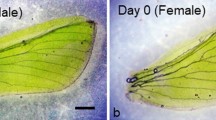Abstract
The outline of the adult wing of lepidopteran insects (butterflies and moths) emerges as a result of disappearance of a group of cells at the periphery of the pupal wing. Histological observation of the pupal wing of Pieris rapae showed that, just after apolysis of the wing epithelium from the pupal cuticle, there occurs a rapid and localized decrease of the number of cells at the periphery of the wing. This decrease occurs through cell death, which lasts 1–1.5 days at 20°C. Dying cells lose contact with the neighbouring cells and show condensation of chromatin and cytoplasm. They then appear to be phagocytosed by neighbouring epithelial cells or discharged through the basal surface of the epithelium into the lumen within the wing and taken up by phagocytes. Fragmentation of DNA in the nuclei was detected in the dead cells or their debris. These results indicate that programmed cell death in the lepidopteran wing proceeds through a mechanism closely similar to that of apoptosis in the vertebrate.
Similar content being viewed by others
References
Abrams JM, White K, Fessler LI, Steller H (1993) Programmed cell death during Drosophila embryogenesis. Development 117:29–43
Dohrmann CE, Nijhout HF (1988) Development of the wing margin in Precis coenia (Lepidoptera: Nymphalidae). J Res Lepid 27:151–159
Ellis RE, Yuan J, Horvitz HR (1991) Mechanisms and functions of cell death. Annu Rev Cell Biol 7:663–698
Fahrbach SE, Choi MK, Truman JW (1994) Inhibitory effects of actinomycin D and cycloheximide on neuronal death in adult Manduca sexta. J Neurobiol 25:59–69
Fristrom D, Wilcox M, Fristrom J (1993) The distribution of PS integrins, laminin A and F-actin during key stages in Drosophila wing development. Development 117:509–523
Garcia-Martinez V Macias D, Ganan Y, Garcia-Lobo JM, Francia MV, Fernandez-Teran MA, Hurle JM (1993) Internucleosomal DNA fragmentation and programmed cell death (apoptosis) in the interdigital tissue of the embryonic chick leg bud. J Cell Sci 106:201–208
Gavrieli Y, Sherman Y, Ben-Sasson SA (1992) Identification of programmed cell death in situ via specific labeling of nuclear DNA fragmentation. J Cell Biol 119:493–501
Glücksmann A (1951) Cell deaths in normal vertebrate ontogeny. Biol Rev 26:59–86
Kerr JFR, Harmon BV (1991) Definition and incidence of apoptosis: a historical perspective. In: Tomei LD, Cope FO (eds) Apoptosis: the molecular biology of cell death. Cold Spring Harbor Laboratory Press, New York, pp 5–30
Lockshin RA, Beaulaton J (1979) Programmed cell death. Electrophysiological and ultrastructural correlations in metamorphosing muscles of lepidopteran insects. Tissue Cell 11:803–819
Martin SJ, Green DR, Cotter TG (1994) Dicing with death — Dissecting the components of the apoptosis machinery. Trend Biochem Sci 19:26–30
Oppenheim RW, Prevette D, Tytell M, Homma S (1990) Naturally occurring and induced neuronal cell death in the chick embryo in vivo requires protein and RNA synthesis: evidence for the role of cell death genes. Dev Biol 138:104–113
Pautou M-P (1975) Morphogenèse de l'autopode chez l'embryon de poulet. J Embryol Exp Morphol 34:511–529
Saunders JWJ (1966) Death in embryonic systems. Science 154:604–612
Schwartz LM (1991) The role of cell death genes during development. BioEssays 13:389–395
Snodgrass RE (1935) Principles of insect morphology. McGrawHill, London
Süffert F (1929) Die Ausbildung des imaginalen Flugelschnittes in der Schmetterlingspuppe. Z Morphol Ökol Thiere 14:338–359
Tata JR (1966) Requirement for RNA and protein synthesis for induced regression of tadpole tail in organ culture. Dev Biol 13:77–94
Toné S, Tanaka S, Kato Y (1983) The inhibitory effect of 5-bromodeoxyuridine on the programmed cell death in the chick limb. Dev Growth Differ 25:381–391
Wago H (1991) Phagocytic recognition in Bombyx mori. In: Gupta AP (ed) Immunology of insects and other arthropods. C.R.C. Press, Florida, pp 215–235
White K, Grether ME, Abrams JM, Young L, Farrell K, Steller H (1994) Genetic control of programmed cell death in Drosophila. Science 264:677–683
Whitten JM (1969) Cell death during early morphogenesis: Parallels between insect limb and vertebrate limb development. Science 163:1456–1457
Wyllie AH, Kerr JFR, Currie AR (1980) Cell death: The significance of apoptosis. Int Rev Cytol 68:251–306
Yoshida A, Aoki K (1989) Scale arrangement pattern in a lepidopteran wing. 1. Periodic cellular pattern in the pupal wing of Pieris rapae. Dev Growth Differ 31:601–609
Zakeri ZF, Quaglino D, Latham T, Locksin RA (1993) Delayed internucleosomal DNA fragmentation in programmed cell death. FASEB J 7:470–478
Author information
Authors and Affiliations
Rights and permissions
About this article
Cite this article
Kodama, R., Yohida, A. & Mitsui, T. Programmed cell death at the periphery of the pupal wing of the butterfly, Pieris rapae . Roux's Arch Dev Biol 204, 418–126 (1995). https://doi.org/10.1007/BF00360849
Received:
Accepted:
Issue Date:
DOI: https://doi.org/10.1007/BF00360849




